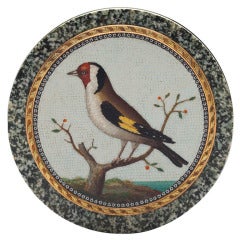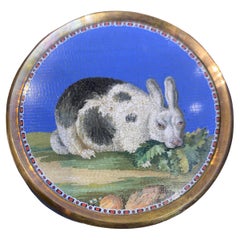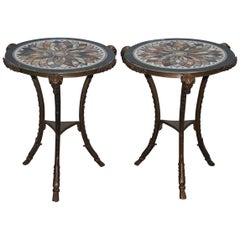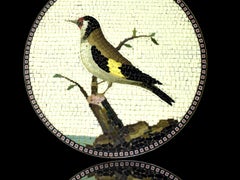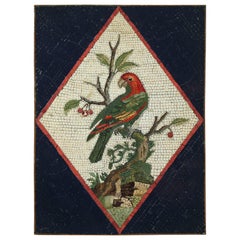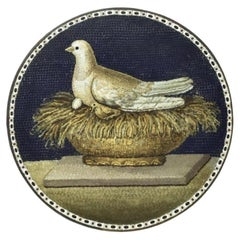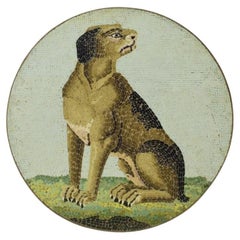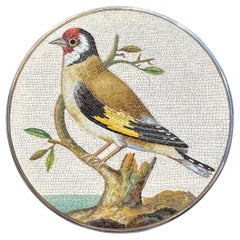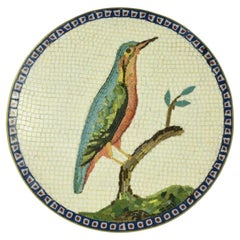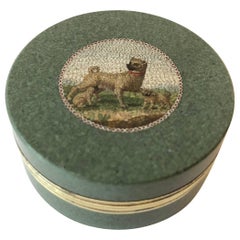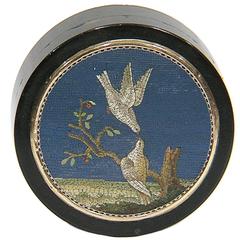Giacomo Raffaelli
Giacomo Raffaelli Micromosaic Box
Located in Amsterdam, NL
. The scene is surrounded by a millefiori border. By Giacomo Raffaelli (1753-1836) Rome, last quarter
Category
Antique Early 19th Century Italian Georgian Boxes and Cases
Materials
18k Gold
18th Century Giacomo Raffaelli Micro Mosaic Rabbit Plaque
Located in New York, NY
18th Century Giacomo Raffaelli Micro Mosaic Rabbit Plaque
A micro mosaic depicting a fat rabbit
Category
Antique 1790s Italian Vanity Items
Giacomo Raffaelli Pietra Dura Louis XVI Bronze Gueridon Specimen Marble Tables
By Giacomo Raffaelli
Located in West Sussex, Pulborough
of Giacomo Raffaelli
A very rare pair in stunning condition throughout, the tops are exceptionally
Category
Antique Late 19th Century French Louis XVI Side Tables
Materials
Marble, Bronze
$28,765 Sale Price / set
30% Off
H 28.35 in W 22.84 in D 25.4 in
19th Century Italian Specimen Pietra Dura Table Attributed To Giacomo Raffaelli
By Giacomo Raffaelli, Gillows of Lancaster & London
Located in London, by appointment only
Century Italian Specimen Pietra Dura Table Top Attributed To Giacomo Raffaelli, set within a carved
Category
Antique Early 19th Century Italian Regency Center Tables
Materials
Agate, Amethyst, Carnelian, Lapis Lazuli, Malachite, Belgian Black Marbl...
$53,422 Sale Price
40% Off
H 30 in Dm 39.5 in
Giacomo Raffaelli signed & dated 1784, Rare Micromosaic Plaque of the Goldfinch
Located in Aspen, CO
clearly) Giacomo Raffaelli fece 1784 Roma. Translation: Giacomo Raffaelli made this. 1784 Rome.
Giacomo
Category
Antique 1780s Italian George III Brooches
$19,160 Sale Price
20% Off
Late 18th Century Micromosaic with Parrot on a branch. From a Model by G.Raffael
By Giacomo Raffaelli
Located in Paris, FR
Large micro-mosaic plate representing a parrot on a branch. From a model by Giacomo Raffaelli. The
Category
Antique 1790s Italian Classical Roman Models and Miniatures
Materials
Art Glass, Cut Glass
$45,054
H 5.71 in W 0.16 in D 4.34 in
Italian Gold-Mounted Micromosaic Snuff Box
Located in New York, NY
grass.
Circle of Giacomo Raffaelli (1753-1836).
Rome, Italy, circa 1800s.
Mosaic measures 2 in.
Category
Antique Early 19th Century Italian Snuff Boxes and Tobacco Boxes
Materials
Glass
18th Century Micromosaic, Rome, c. 1795, Attributed to G. Raffaelli
Located in Aspen, CO
18th century micromosaic of a turtle dove on her nest with a chick, attributed to Giacomo Raffaelli
Category
Antique 1790s Italian Georgian Desk Accessories
18th Century Micromosaic Plaque, possibly by G. Raffaelli, c. 1780
Located in Aspen, CO
that this micromosaic was probably Giacomo Raffaelli; however to be conservative we would say it is
Category
Antique 1780s Italian Georgian Brooches
18th Century Goldfinch Micro Mosaic Box
Located in New York, NY
attributed to the late 18th century artist Giacomo Raffaelli. Made circa 1790
Diameter: 3"
Height: 1.63
Category
Antique 1790s Italian Boxes and Cases
Materials
Silver, Sterling Silver
18th Century Micromosaic Plaque of a Bluebird, attributed to G. Raffaelli.
Located in Aspen, CO
18th Century micromosaic plaque of a bluebird, Rome, c. 1785, attributed to Giacomo Raffaelli (1753
Category
Antique 1780s Italian Georgian Brooches
Small Plate with Greyhound
Located in Roma, IT
Slate finely decorated with micromosaic. Designed as a pin.
Rome, atelier of Giacomo Raffaelli
Category
Antique 1830s Italian Modern Animal Sculptures
Materials
Stone, Metal
18th Century Micromosaic of a Goldfinch, c. 1790, attributed to G. Raffaelli
Located in Aspen, CO
18th Century micromosaic plaque of a Goldfinch, Rome, c. 1785, attributed to Giacomo Raffaelli
Category
Antique 1790s Italian Georgian Brooches
Rare 19th Century Italian Micromosaic, the Capitoline Doves
Located in Vicoforte, IT
Giacomo Raffaelli. This technique reached its peak in the mid-19th century thanks to the production of
Category
1850s More Art
Materials
Mosaic
$17,784
H 17.72 in W 20.48 in D 2.37 in
Antique Venetian Etched Glass Mirror with Pate de Verre Micro Mosaic
By Vintage Murano Gallery
Located in Ballard, CA
invisible. This delicate decoration was created by two craftsmen Cesare Aguatti and Giacomo Raffaelli who
Category
Antique Mid-19th Century Italian Wall Mirrors
Materials
Wire
$6,500
H 21 in W 16.25 in D 2.5 in
Mausoleum of Cecilia Metella on the Appian Way, Early 19th Century Circular
Located in Paris, FR
1800 and 1815. This model is probably a work of the Vatican workshops in which Giacomo Raffaelli worked
Category
Antique Early 1800s Italian Empire Models and Miniatures
Materials
Marble
$69,952
H 6.89 in W 6.89 in D 0.4 in
19th C. Italian Grand Tour Micro-Mosaic "Doves of Pliny" Box After Antiquity
By Vatican Mosaic Studio
Located in Atlanta, GA
depicting the Capitoline Doves or Doves of Pliny after the Roman antiquity. Also by legendary maker Giacomo
Category
Antique Late 19th Century Italian Grand Tour Decorative Boxes
Materials
Slate, Bronze
$1,196 Sale Price
20% Off
H 3.375 in Dm 4.25 in
Antique Italian Micromosaic Gold Brooch-Pendant And Earrings Suite, Circa 1850
Located in London, GB
took commissions. The majority of micromosaics are unsigned, although Gioacchino Barberi and Giacomo
Category
Antique 1860s Italian Etruscan Revival Drop Earrings
Materials
Gold
Antique Italian Micromosaic Gold Brooch-Pendant And Earrings Suite, Circa 1870
Located in London, GB
Barberi and Giacomo Raffaelli were master craftsmen who did sign their pieces.
The micromosaics were
Category
Antique 1870s Italian Victorian Drop Earrings
Materials
Gold
Recent Sales
Small Hardstone Box Set with a Micromosaic Attributed by Giacomo Raffaelli
By Giacomo Raffaelli
Located in Hilversum, NL
mark GS 8 in lozenge.
The micromosaic was probably made by Giacomo Raffaelli, an expert
Category
Antique Early 1800s Italian Decorative Boxes
Materials
Stone, Silver
Tortoise Shell and Gold Box with Micromosaic by Raffaelli, Rome, 18th Century
By Giacomo Raffaelli
Located in Rome, IT
olive branch. Giacomo Raffaelli (1753-1836), Rome, late 18th century.
Category
Antique Late 18th Century Italian Neoclassical Decorative Boxes
Materials
Tortoise Shell
Tortoise Shell and Gold Box with Micromosaic by Raffaelli, Rome, 18th Century
By Giacomo Raffaelli
Located in Rome, IT
on a dark blue/ green background. Giacomo Raffaelli (1753 - 1836), Rome, late 18th century.
Category
Antique Late 18th Century Italian Neoclassical Decorative Boxes
Materials
Tortoise Shell
Pill Box, Lavic Rock and Gold, Micromosaic Depicting Goldfinch, 18th Century
By Giacomo Raffaelli
Located in Rome, IT
mosaicist Giacomo Raffaelli (1753-1836).
Category
Antique Late 18th Century Italian Neoclassical Decorative Boxes
G. Raffaelli Attributed to an Italo-French Pietre Dure Gueridon, circa 1825
By Giacomo Raffaelli
Located in Paris, FR
mosaic medallion represents a dancing putto.
A similar table top was made by Giacomo Raffaelli (1753
Category
Antique 19th Century French Center Tables
Materials
Marble
Roman Pietre Dure-Top Attributed to Raffaelli on an Anglo-Indian Ebony Table
By Giacomo Raffaelli
Located in London, GB
may be made to the most celebrated mosaicist working in Rome, Giacomo Raffaelli (1753-1836), whose
Category
Antique 1820s Italian Neoclassical Gueridon
Materials
Marble
A Superb Ormolu And Cast Iron Center Table With Specimen Marble.
By Giacomo Raffaelli
Located in New York, NY
A superb ormolu and cast iron center table with specimen marble top by Giacomo Raffaelli, Rome
Category
Antique 19th Century English Center Tables
Materials
Marble, Iron
Roman Micromosaic Depicting Pliny’s Doves
Located in Roma, IT
subject signed by Giacomo Raffaelli and dated 1801 can be seen as part of the Rosalinde and Arthur Gilbert
Category
Antique 19th Century Italian Grand Tour Decorative Art
Dove Micromosaic Gold Vertical Ring Italian 1780-1790 Attr. Giacomo Raffaelli
Located in Firenze, IT
attributed to the master mosaicist Giacomo Raffaelli (1753-1836) or his studio, active in Rome in the late
Category
Antique 1780s Italian Fashion Rings
Materials
14k Gold, Gold
Early 19th Century Micromosaic Gold-Mounted Hardstone Bonbonnière
By Giacomo Raffaelli
Located in Paris, FR
as Cesare Aguatti et Giacomo Raffaelli, or Volpini who worked in the Vatican workshops.
The box is
Category
Antique Early 1800s Italian Empire Decorative Boxes
Materials
Gold
Late 18th Century Gold and Micromosaic Ring
Located in Firenze, IT
the school of the master mosaicist Giacomo Raffaelli (1753-1836)
Category
Antique Late 18th Century Italian Neoclassical Fashion Rings
Materials
Gold, 18k Gold
"Micromosaic of the Doves"
Located in Vicenza, VI
mosaicists, Giacomo Raffaelli, namely "Pliny's doves": they represent four doves on the edge of a bronze
Category
Antique Mid-19th Century Italian Empire Models and Miniatures
Materials
Marble
Oval Micro-Mosaic Mirror
Located in Paris, FR
was created by two craftsmen Cesare Aguatti and Giacomo Raffaelli who invented tesserae made of spun
Category
Antique 1870s Italian Table Mirrors
Materials
Glass
Antique Italian Micromosaic and Gold Earrings, Circa 1870
Located in London, GB
Giacomo Raffaelli were master craftsmen who did sign their pieces. The micromosaics were usually sold
Category
Antique 1870s Italian Etruscan Revival Drop Earrings
Materials
Gold
Important Micromosaic of Two Guinea Pigs Eating Cabbage and Grapes
Located in New York, NY
Giacomo Raffaelli
With red mosaic outline and black marble border, backed with an iron-inset white marble
Category
Antique 19th Century European Decorative Art
Materials
Stone
Late 18th Century Gold & Micromosaic Brooch/Pendant Attr. Giacomo Raffaelli
Located in Firenze, IT
mounting.
Attributable to the school of the master mosaicist Giacomo Raffaelli (1753-1836)
Category
Antique Late 18th Century Italian Neoclassical Brooches
Materials
Gold, 18k Gold
Antique Ebonized Louis XVI Gilt Bronze Corinthian Pillar Gueridon Marble Table
Located in West Sussex, Pulborough
master of micromosaic, Giacomo Raffaelli held the earliest known exhibition of such works in his Roman
Category
Antique 1840s European Louis XVI Tables
Materials
Marble
People Also Browsed
Belle Époque Diamond Tiara
Located in London, GB
A Belle Époque diamond tiara, to the centre three diamond-set clusters with diamond-set foliate decorations and one large diamond-set cluster on each side, all within a waved frame o...
Category
Early 20th Century French Belle Époque More Jewelry
Materials
Diamond, Platinum
19th Century Chinese Pagoda Cabinet
Located in Houston, TX
A stunning and rare 19th Century English Chinese pagoda cabinets. This highly stylized hand carved mahogany cabinets features, glass shelving, pagoda gabled roofs, classic Chippendal...
Category
Antique 19th Century English Chinese Chippendale Vitrines
Materials
Glass, Mahogany
Hermès Mini Kelly 20cm Sellier Bag Shiny Red Lizard Gold Hdw Vintage
By Hermès
Located in FR
Adorable and Cutest ever Authentic Hermès Mini Kelly
Among the most coveted Hermès bags
Sellier Version, rigid, so chic !
Will come with its matching pencil case and ring scarf cl...
Category
Late 20th Century French Top Handle Bags
$42,386 Sale Price
35% Off
H 5.52 in W 3.15 in L 7.88 in
Bulgari Vintage 18k Yellow Gold Gas Lighter
By Bulgari
Located in New York City, NY
Unleash a Whimsical Flame: Bulgari Vintage 18k Yellow Gold "Snail" Gas Lighter
This isn't just a lighter; it's a captivating conversation starter and a whimsical treasure from Bulgar...
Category
Late 20th Century Desk Accessories
Materials
Yellow Gold, 18k Gold
BUCCELLATI Aquamarine Diamond Ruby 18k Yellow Gold Ring
By Gianmaria Buccellati
Located in New York, NY
This exquisite vintage Gianmaria Buccellati cocktail ring is crafted in 18k brushed and textured yellow gold with white gold accents. This ring is set with a faceted oval 7.0mm x 10....
Category
1990s Cocktail Rings
Materials
Aquamarine, Diamond, Ruby, Yellow Gold
Christian Dior by John Galliano Sheer Bronze Gold Knit Mini Dress 1999 2000
By John Galliano, Christian Dior
Located in Berlin, BE
Christian Dior by John Galliano
Fall 1999/ 2000
Extremely sexy dress by John Galliano for Dior - a dress that transcends mere fabric to become an emblem of audacious elegance. This...
Category
1990s Italian Evening Dresses and Gowns
Dolce & Gabbana Swarovski Crystal Mesh Fringed Lace-Up Evening Dress, FW 2003
By Dolce & Gabbana
Located in London, GB
▪ Brand: Dolce & Gabbana
▪ Creative Director: Domenico Dolce and Stefano Gabbana
▪ Collection: Fall-Winter 2003
▪ Fabric: 100% Real Crystal
▪ Details: Museum Grade
▪ Size: IT40 - FR...
Category
Early 2000s Italian Evening Dresses and Gowns
$65,750
Size: IT40 - FR36 - UK8 - US4
Gucci by Tom Ford Red Sheepskin Floor-Length Double-Breasted Coat, fw 1996
By Tom Ford for Gucci, Gucci
Located in London, GB
▪ Archival Gucci Runway Coat
▪ Creative Director: Tom Ford
▪ Fall-Winter 1996
▪ Crafted from multiple panels of red-dyed sheepskin with a leather backing, this coat exudes luxurious ...
Category
1990s Italian Coats and Outerwear
$35,614
Size: IT40 - FR36 - UK8 - US4
1 of 1 Atelier Versace S/S 2005 Gold Oroton and Blue Swarovski Chainmail Top
By Atelier Versace
Located in Rome, IT
1 of 1 Atelier Versace Metal Mesh Low cut Top from Spring/Summer 2005.
Double Gold Oroton and Blue Swarovski Chainmail with internal nude corset. Iconic gold Medusa logo plaques on...
Category
Early 2000s Italian Tank Tops
$29,640 Sale Price
28% Off
Size: XS
Stunning Thierry Mugler Archival FW 1986 Evening Gown Crystal Black Dress
By Thierry Mugler
Located in Berlin, BE
Gorgeous extremely rare Iconic Thierry Mugler Evening Dress, FW 1986 Collection "Les Voleuses"
Museum worthy Collectors Piece
The most dramatic evening gown with amazing crystal rhi...
Category
1980s French Evening Dresses and Gowns
1930 Art Deco Golden Silk Net & Sequin Hollywood Starlet Gown
Located in Gresham, OR
A divine 1930s Hollywood Starlet Gown: Spaghetti straps, gathered bust radiates down to the hem in golden sequined rays on gold silk tulle netting! Gold satin lining fabric, side sn...
Category
1930s American Evening Gowns
Rare Archival Thierry Mugler Goddess Gown 1979 Eveing Dress
By Thierry Mugler
Located in Berlin, BE
Stunning extremely rare Thierry Mugler Goddess Gown from one of his earliest Collections ca.1979.
A masterful embodiment of ethereal elegance and avant-garde artistry.
The dress cas...
Category
1970s French Evening Dresses and Gowns
Vivienne Westwood red and cream Harris Tweed corseted skirt suit, fw 1995
By Vivienne Westwood
Located in London, GB
Vivienne Westwood red and cream checked Harris Tweed three piece skirt suit comprising: halter-neck waistcoat with sixteen button fastenings, built-in corset and large lapels, equest...
Category
1990s British Suits, Outfits and Ensembles
Alexander McQueen metallic silver silk lamé open-back evening dress, ss 1997
By Alexander McQueen
Located in London, GB
▪ Alexander McQueen metallic silver silk lamé evening dress
▪ V-neck
▪ Open back with a belted waist
▪ Accordion pleated panel starting at the hip and finishing into a train
▪ Conce...
Category
1990s Italian Evening Dresses and Gowns
$13,698
Size: IT 44 - FR 40 - UK 12 - US 8
Alexander McQueen 2007 Collection Castle Skeleton Fairy Open Back Silk Gown 40
By Alexander McQueen
Located in Montgomery, TX
Alexander McQueen Black Silk Dress Gown
2007 Collection
Designer Size - 40.
100% Silk.
Colors - Black and Gray, Print of Castle and Winged Skeletons.
Cowl Neckline, Sleeveless, Back ...
Category
Early 2000s Italian Evening Gowns
Jean Paul Gaultier gold lace and silk organza corseted jacket, ss 1988
By Jean Paul Gaultier
Located in London, GB
Jean Paul Gaultier gold lace corseted jacket backed with black silk organza.
Spring-Summer 1988
Category
1980s Italian Jackets
$5,479
Size: IT 42 - FR 38 -UK 10 - US 6
Get Updated with New Arrivals
Save "Giacomo Raffaelli", and we’ll notify you when there are new listings in this category.
Giacomo Raffaelli For Sale on 1stDibs
With a vast inventory of beautiful furniture at 1stDibs, we’ve got just the giacomo raffaelli you’re looking for. Each giacomo raffaelli for sale was constructed with extraordinary care, often using stone, marble and metal. You’ve searched high and low for the perfect giacomo raffaelli — we have versions that date back to the 18th Century alongside those produced as recently as the 19th Century are available. A giacomo raffaelli, designed in the Neoclassical, Empire or Louis XVI style, is generally a popular piece of furniture. A well-made giacomo raffaelli has long been a part of the offerings for many furniture designers and manufacturers, but those produced by Giacomo Raffaelli are consistently popular.
How Much is a Giacomo Raffaelli?
The average selling price for a giacomo raffaelli at 1stDibs is $40,899, while they’re typically $12,996 on the low end and $450,000 for the highest priced.
More Ways To Browse
Antique Mercury Glass Mirrors
Murano Etched Glasses
Venetian Mirror Murano
Venetian Murano Glass Mirror
Small Metal Sculptures
Mosaic Italian Mirror
Greyhound Sculpture
Italian 19th Century Inlay Table
Mid Century Etched Mirror
Portrait Miniatures
Roman Marble Head
Marble Specimen Table
Portoro Table
Grand Tour Bronze Roman
Specimen Collectors Cabinet
Lapis Lazuli Table Top
Antique Wooden Canes
Gillow Rosewood
